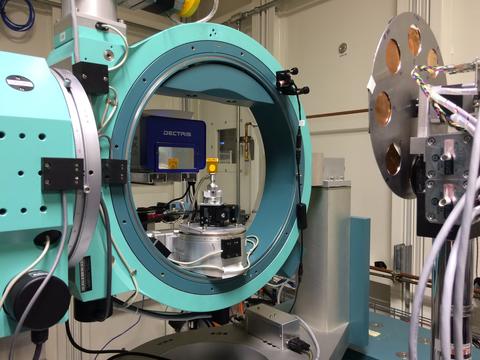Synchrotron X-ray Diffraction (XRD)

View of the sample area in the X-ray Diffraction (XRD) end station on the Beamline for Material Measurement (BMM).
The X-ray diffraction (XRD) end station measures constructive interference of the x-ray wave with repeating atomic and interfacial structure in materials. At the Beamline for Material Measurement, XRD features a tunable, monochromatic, high intensity beam with a beam spot on the order of 100 micrometers. The high energy beam (4.5 keV to 23 keV) is combined with a six-circle Ψ goniometer for measurement of thin films as well as single and polycrystalline materials. The instrument features point, strip, and area detectors. Potential users should note that the instrument was designed with center of the "chi" circle aligned to the axis of rotation rather than offset. This results in a small region to mount the sample, making the mounting of large samples and some sample environments challenging. Users are encouraged to discuss potential samples with the instruments scientists very early in the planning process. XRD has been designed, built, and continues to operate through a partnership with IBM.
X-ray diffraction is a foundational technique in materials science and engineering, providing information on regularly occurring and well defined structures such as crystal lattices or interfaces in multilayer materials. The small, intense beam at BMM is key to probing small areas of a larger sample with macroscopic heterogeneity such as a patterned substrate or device. The brilliance of the source facilitates examination of structural changes due to small concentrations of elements in doping applications that would be prohibitive to measure on a lab-based source. Additionally, the use of the tunable energy of the beam provides a route to alter the contrast of elements as the energy approaches the excitation energy of elemental core electrons. The "anomalous" diffraction that results is key to separating the contributions of different elements in many complex materials used across the manufacturing spectrum.
Specifications/Capabilities
Information about the beamline, including training, control software, sample cameras, and upgrade activities can be found at the BMM Wiki
Usage Information
Operating Schedule
Access Information
All users are encouraged to discuss potential experiments with the relevant instrument scientists prior to applying for access. XRD at BMM has been designed, built, and continues to operate through a partnership with IBM. Access to XRD on BMM is granted through one of two mechanisms:
1) General users may apply for time through the general user program at NSLS-II. Qualifications, proposal templates, and guidelines are available at https://www.bnl.gov/ps/userguide/.
2) For NIST staff: NIST projects may request access for experiments by contacting the instrument scientists listed here. Requests are collected and reviewed by the NIST BNL allocation committee and granted time based on merit and fit to the NIST mission. For more information, contact the instrument scientist listed here.

